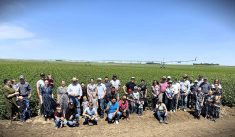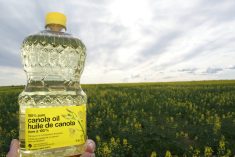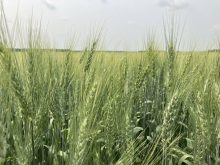Canola acres are down substantially this year but that’s not because growers’ fondness for their Cinderella crop has diminished.
In fact, most are pretty excited about what lies ahead, said Alberta Canola vice-chair Ian Chitwood.
“I think people are quite optimistic by how the market is looking and how things are looking for canola,” said Chitwood, who farms east of Airdrie.
“As the biofuel regulations get updated — and we’re going to see them in June — we’re extremely excited about having another market that we can get into, especially with some questions about global trade.
“If we can open up a domestic market for fuel, that will be a huge one for producers.”
Given the rapid rise in renewable diesel, huge might be an understatement.
Unlike biodiesel, renewable diesel is virtually identical to the petroleum version, so it doesn’t have to be blended and can be used in diesel engines without modifications. And a host of companies are rushing to build refineries that can turn vegetable oil or other feedstocks into this green fuel.
South of the border, production is expected to hit 130,000 barrels a day this year (from virtually nothing a decade ago). On the Prairies, two major renewable diesel refineries are in the works — one in Regina and the other near Edmonton where Imperial Oil is building a 20,000-barrel-a-day facility next to its Strathcona oil refinery.
That plant, expected to be operational in 2024, will be the biggest in the country, said Steve Pratte, senior manager of transportation and biofuels with the Canadian Canola Growers Association.
“It’s the quickest signal to the market that they’re getting the big major players involved,” he said.
When it was announced last year, a company official said Imperial would be looking at canola, soy, and camelina oils as feedstocks — but Chitwood is expecting it will be a lot of the former.
“They will create a lot of demand for local producers,” he said. “They will open up a huge buyer for a lot of the canola coming out of the Peace Country and area north of Edmonton. That’s going to be really big.”
A good problem to have
Back in 2015 — long before the rise of renewable diesel — the Canola Council of Canada launched its Keep it Coming 2025 initiative to boost production to 26 million tonnes annually.
The trend looked promising for a while. Production hit 21.5 million tonnes in 2017 but has since been closer to 20 million annually and plummeted to 12.6 million last year because of drought.
And StatCan says the area seeded to canola this year will fall to 20.9 million acres nationally (from 22.5 million a year ago) with 6.3 million of those acres in Alberta (versus 6.7 million a year ago).
That’s not only keeping canola futures in the stratosphere right now but also has many questioning whether producers can satisfy demand for both the food and energy markets.
It’s on the minds of farmers, too, said Chitwood.
“I know all the producers that I’ve talked to have said, ‘How are we going to fill all this demand if one of these projects goes through and be able to fulfil our global obligations, too?’”
But Chitwood doesn’t see that as a problem.
First, he said, productivity is steadily increasing — even if that’s been obscured lately by weather or acreage numbers.
And second, having lots of demand from diverse markets is a good problem to have.
“If we continue to increase production, all it takes is one disruption, and we’re searching for a new market,” he said. “I think it’s better to build a domestic market, and it’s way better to have supply chasing demand, than the other way around.
“Any way we can build domestic demand, that’s a win for industry.”
‘Generational tipping point’
“We’re sitting at the cusp of some major changes to the biofuel landscape in Canada,” he said. “It’s got a lot to do with the forthcoming Clean Fuel Regulations… These regulations have been in the works for the past seven years, and will be released by June 21.”
Although government regulations don’t typically set the heart aflutter, these rules aimed at substantially reducing the overall carbon intensity of fuels used in Canadian vehicles will have wide-ranging repercussions.
“I think we’re at one of those generational tipping points where we are going to see an increase in biofuel production and biofuel use, under all these environmental policies and decarbonization policies,” said Pratte. “Certainly, if this all takes off, there will be an incremental demand pull for industrial use, which we haven’t had up until now.”
Couple that with increased global demand for vegetable oil and the ongoing expansion of the Canadian crush sector, and growers can look forward to steady markets and that “should keep prices from going wildly all over the place,” he said.
And price stability, in turn, increases the economic incentive for farmers to increase yields through improved agronomy, better genetics, and best management practices, he added.
“The industrial investment will be ideally coinciding with more bushels per acre from the farmers,” said Pratte.
















